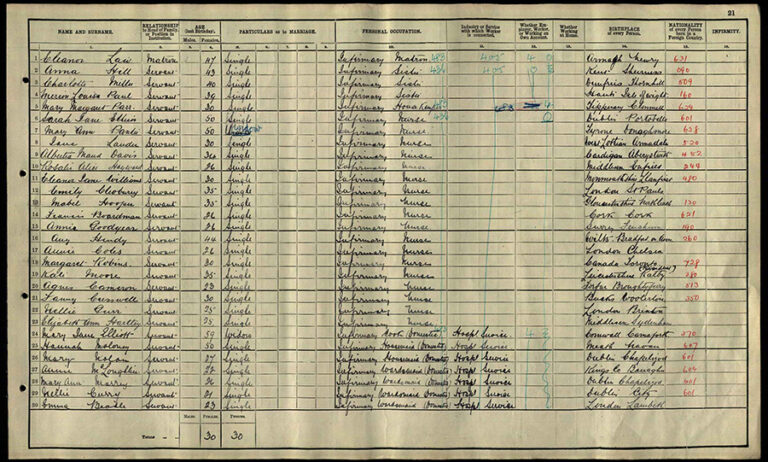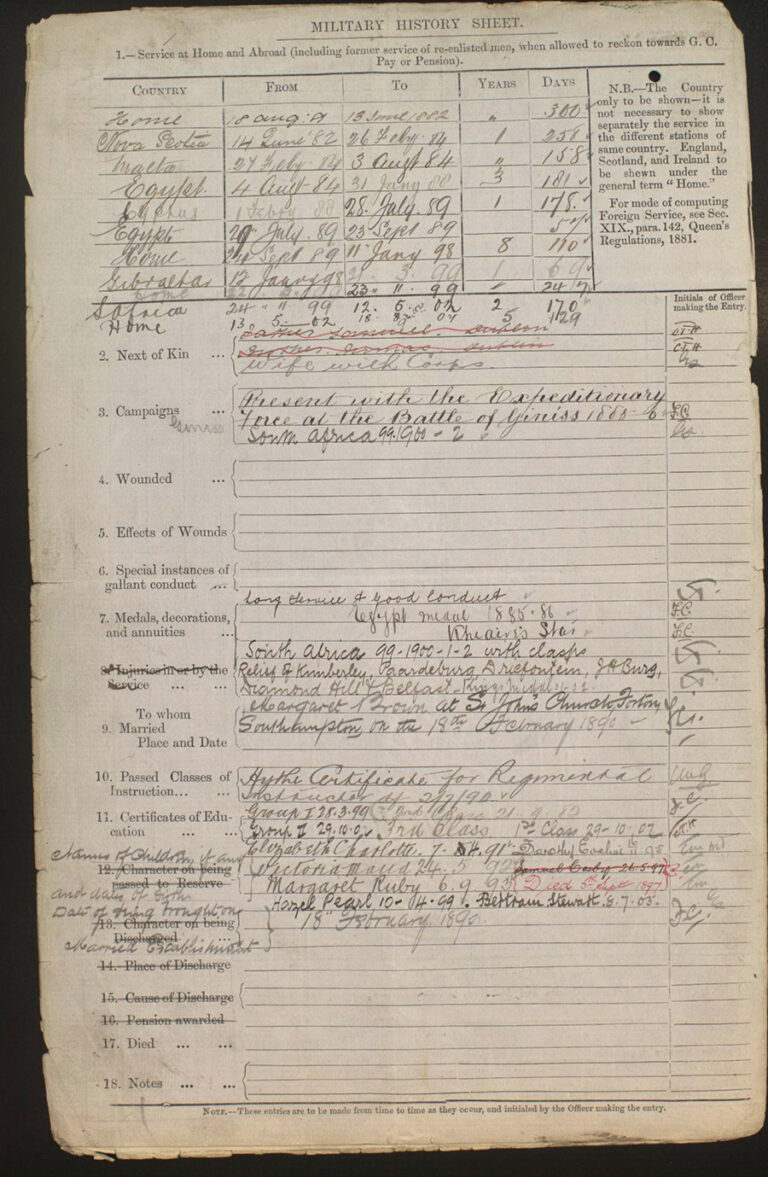In this second blog exploring what kind of research might be undertaken using the minutes of the Board of the Royal Hospital Chelsea (RHC) (see Part 1 here), I wanted to focus on information which might be found about those living and working at the hospital before the outbreak of the First World War in 1914. Many of whom would still be present during the conflict, and are found in the minutes we have been transcribing.
In June 1916 at a meeting of the Board of the RHC, it was announced that a current employee of the hospital, Miss Rosalie Alice Hayward, was to be appointed to the post of Sister. Rosalie was, indeed, a career nurse. In fact, she can be found in the 1911 Census already working at the RHC. Here, at the age of 26, she is listed as an ‘Infirmary Nurse’ along with all of her colleagues.

Rosalie’s presence here permits us to look at previous pages which include entries for all of the in-pensioners, former soldiers, now residing at the RHC. In fact, the 1911 Census provides a fascinating insight into those living and working at the hospital. As well as the former soldiers, those working on the premises included the hospital chaplain, clerks, surgeons, gardeners, dressmakers, an organist, chauffeurs and housekeepers, all of whom lived at the site with their husbands, wives and children (who are also listed in the census return), can be found.
As you might expect, those resident at RHC came from all over Britain and its Empire. On the opening page of the census return for the hospital, the first two entries are for Gladys and Georgina White, the former born in Kew, London, the latter in Calcutta, India – under each of their occupations is listed, perhaps strangely, ‘Daughter of Field Marshal Sir George White’, who was Governor of RHC from 1905 until his death in 1912.
Included in the many families listed is Samuel Casby Eastwood, born in Dublin, Ireland, and listed as ‘Army Pensioner Sergeant Major Royal Hospital’, who is present alongside his wife Margaret, born in Mauritius, and their five daughters: Elizabeth, Victoria, Margaret and Dorothy, and two sons: Bertram and Royal. The children’s places of birth reflect their father’s military service and highlight areas in which he was stationed: Gosport; Richmond in Yorkshire (Samuel was a member of the Yorkshire Regiment, based in Richmond); Kildare (specifically the Curragh Camp, the largest military camp in Ireland); Gibraltar; and, finally, Chelsea.

According to his surviving service record found in the WO 97 series, Samuel joined the Yorkshire Regiment in 1881 in Belfast, at the age of 15. At the time, he was 5 feet 4 inches tall, weighed 92 pounds, and had blue eyes and light-brown hair. The record also states that he had ‘a slight scar on his left forearm’. Samuel served in the regiment beyond the usual 21 years of service, finally retiring as a Sergeant Major in 1907 – it is noted that he was a competent clerk, and was qualified to teach gymnastics. He had served in the United Kingdom, Nova Scotia, Malta, Egypt (twice), Cyprus, Gibraltar and South Africa, the latter during the conflict in 1899-1902. His record also lists two other children in addition to the seven listed above, both of whom did not survive childhood: Samuel Casby (who died at three and a half months old) and Hazel Pearl. Among his records is also included a death certificate, which records Samuel’s death, at the age of 75 on 22 July 1940.

Using other records of the RHC it is also possible to find out a little more about some of the in-pensioners listed in the 1911 Census, some of whom also come up in the records of the Board. In 1911, Ambrose Adolphus Knight is listed as a 69-year-old in-pensioner, born in Coventry. According to his in-pensioner record in the WO 23 series, he entered the hospital on 1 August 1909. He had been a soldier in the 1/4th Regiment of Foot, serving in the ‘East Indies’ and Abyssinia, serving in total for nearly eight years. He is recorded to have ‘weak sight’ and that he was of ‘very good’ character.
Townsend Frederick Baldwin was discharged as a Gunner from the Royal Artillery on 19 March 1879. He had served in the regiment for just short of 23 years. For nearly 20 years of that time, he had served continuously in India. His conduct was described as good (which would help in his bid to become an in-pensioner), and that he was in possession of four good conduct badges, and a Silver Badge for Long Service. Townsend was originally from County Clare, Ireland. His service began in 1858, which meant that his original attestation was into the East India Company Artillery, before it was absorbed as part of the British Army after the insurrections in India during that year. He was not admitted into the RHC until 1 August 1907, 28 years after he had left the army.

There are so many possibilities to explore further using these records, and I have merely scratched the surface. There are undoubtedly many other stories waiting to be found if you are prepared to look for them!
Learn more about Scarlets and Blues and volunteer on the project.